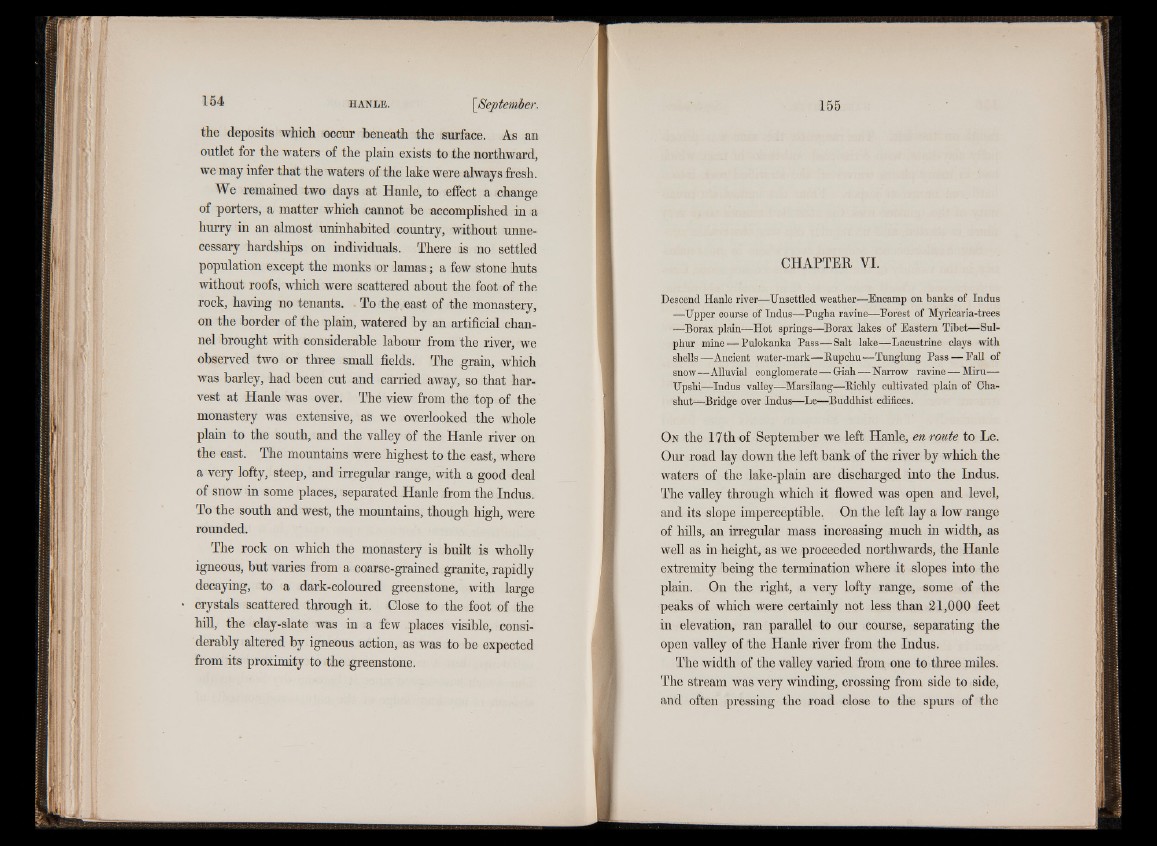
1^4 h a n l e . [September.
the deposits which occur beneath the surface. As an
outlet for the waters of the plain exists to the northward,
we may infer that the waters of the lake were always fresh.
We remained two days at Hanle, to effect a change
of porters, a matter which cannot be accomplished in a
hurry in an almost uninhabited country, without unnecessary
hardships on individuals. There is no settled
population except the monks or lamas; a few stone huts
without roofs, which were scattered about the foot of the
rock, having no tenants. To the east of the monastery,
on the border of the plain, watered by an artificial channel
brought with considerable labour from the river, we
observed two or three small fields. The grain, which
was barley, had been cut and carried away, so that harvest
at Hanle was over. The view from the top of the
monastery was extensive, as we overlooked the whole
plain to the south, and the valley of the Hanle river on
the east. The mountains were highest to the east, where
a very lofty, steep, and irregular range, with a good deal
of snow in some places, separated Hanle from the Indus.
To the south and west, the mountains, though high, were
rounded.
The rock on which the monastery is built is wholly
igneous, but varies from a coarse-grained granite, rapidly
decaying, to a dark-coloured greenstone, with large
crystals scattered through it. Close to the foot of the
hill, the clay-slate was in a few places visible, considerably
altered by igneous action, as was to be expected
from its proximity to the greenstone.
155
CHAPTER VI.
Descend Hanle river—Unsettled weather—Encamp on banks of Indus
—Upper course of Indus—Pugha ravine—Eorest of Myricaria-trees
—Borax p la in ^H o t springs—Borax lakes of Eastern Tibet—Sulphur
mine — Pulokanka Pass— Salt lake—Lacustrine clays with
shells— Ancient water-mark— Kupchu'—Tunglung Pass — Fall of
snow—Alluvial conglomerate— Griah — Narrow ravine— Miru—
Upshi—Indus valley—Marsilang—Bichly cultivated plain of Cha-
shut—Bridge over Indus—Le—Buddhist edifices.
O n the 17th of September we left Hanle, en route to Le.
Our road lay down the left bank of the river by which the
waters of the lake-plain are discharged into the Indus.
The valley through which it flowed was open and level,
and its slope imperceptible. On the left lay a low range
of hills, an irregular mass increasing much in width, as
well as in height, as we proceeded northwards, the Hanle
extremity being the termination where it slopes into the
plain. On the right, a very lofty range, some of the
peaks of which were certainly not less than 21,000 feet
in elevation, ran parallel to our course, separating the
open valley of the Hanle river from the Indus.
The width of the valley varied from one to three miles.
The stream was very winding, crossing from side to side,
and often pressing the road close to the spurs of the